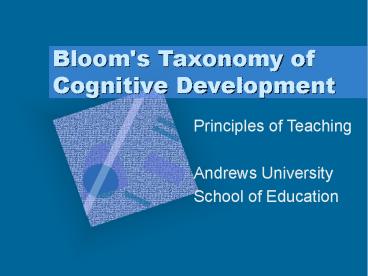Bloom's Taxonomy of Cognitive Development - PowerPoint PPT Presentation
Title:
Bloom's Taxonomy of Cognitive Development
Description:
Title: Bloom's Taxonomy of Cognitive Development Author: School of Education - Teaching and Learning Last modified by: Bradley William Sheppard Created Date – PowerPoint PPT presentation
Number of Views:542
Avg rating:3.0/5.0
Title: Bloom's Taxonomy of Cognitive Development
1
Bloom's Taxonomy of Cognitive Development
- To insert your company logo on this slide
- From the Insert Menu
- Select Picture
- Locate your logo file
- Click OK
- To resize the logo
- Click anywhere inside the logo. The boxes that
appear outside the logo are known as resize
handles. - Use these to resize the object.
- If you hold down the shift key before using the
resize handles, you will maintain the proportions
of the object you wish to resize.
- Principles of Teaching
- Andrews University
- School of Education
2
COGNITIVE DOMAIN
- KNOWLEDGE
- COMPREHENSION
- APPLICATION
- ANALYSIS
- SYNTHESIS
- EVALUATION
3
AFFECTIVE DOMAIN
- RECEIVING
- RESPONDING
- VALUING
- ORGANIZATION
- CHARACTERIZATION
4
PSYCHOMOTOR DOMAIN
- REFLEX MOVEMENTS
- BASIC FUNDAMENTAL MOVEMENTS
- PERCEPTUAL ABILITIES
- PHYSICAL ABILITIES
- SKILLED MOVEMENTS
- NON-DISCURSIVE MOVEMENTS
5
COGNITIVE DOMAIN
- KNOWLEDGE
- USE Records, Films, Videos, Models, Events,
Media, Diagrams, Books... - APPROPRIATE VERBS Define, Identify, List,
Locate, Recall, Discover, Match, Observe, Listen,
Ask...
- Recognize, define, or recall specific
information. - Remembering or recognizing something previously
encountered without necessarily understanding,
using, or changing it. - Remembering important names, dates, capitals, etc.
6
COGNITIVE DOMAIN
- COMPREHENSION
- USE Trends, Consequences, Tables, Cartoons...
- APPROPRIATE VERBS Compare, Summarize, Explain,
Convert, Chart, Associate, Interpret...
- Targets understanding of content
- Summarizing, translating, and providing examples
of a concept - Understanding the material being communicated
without necessarily relating it to anything else
7
COGNITIVE DOMAIN
- APPLICATION
- USE Collection, Diary, Photographs, Sculpture,
Stichery, Illustration... - APPROPRIATE VERBS Apply, Calculate, Practice,
Demonstrate, Construct, Teach, Paint, Manipulate,
Report...
- Focuses on whether students can use information
to solve problems - Using general concepts to solve a particular
problem - Solving math and word problems
- Using punctuation properly
8
COGNITIVE DOMAIN
- ANALYSIS
- USE Graph, Survey, Diagram, Chart,
Questionnaire, Report... - APPROPRIATE VERBS Analyze, Contrast, Deduce,
Differentiate, Distinguish, Infer, Classify,
Categorize, Dissect, Advertise, Survey...
- Breaking something down to reveal its
organization and structure - Breaking something down into parts
- Why a short story works
- identify the component parts of a science
experiment
9
COGNITIVE DOMAIN
- SYNTHESIS
- USE Article, Radio Show, Video, Puppet Show,
Inventions, Poetry, Short Story... - APPROPRIATE VERBS Compose, Create, Design,
Formulate, Produce, Rearrange, Combine, Invent,
Hypothesize, Write...
- Asks students to create a unique (for them)
product by combining different ideas - Writing a poem, painting a picture, creating a
computer program, etc.
10
COGNITIVE DOMAIN
- EVALUATION
- USE Letters, Group with Discussion Panel, Court
Trial, Survey, Self-evaluation, Value,
Allusions... - APPROPRIATE VERBS Appraise, Assess, Critique,
Judge, Support, Debate, Evaluate, Editorialize,
Recommend...
- Highest level of the taxonomy
- Students judge the value or worth of something by
comparing it to predetermined criteria - Solve a pollution problem
- Assess a writing sample
11
BLOOMS TAXONOMY OF COGNITIVE DEVELOPMENT in
Action
- Re-evaluate your groups categories. What
changes would you make? Why? - Write one objective for each level of Blooms
Taxonomy of Cognitive Development
- Independent Practice
- Write 4 Objectives for each domain (affective,
cognitive, psychomotor) - Write 3 objectives for the interpersonal domain
- Indicate Related Domain
- Identify Level within the Cognitive Domain
- Include parts A, B, C, D., but not necessarily
in that order.
12
Mr. Sheppard is enjoying his evening as he reads
students objectives for Principles Class.































